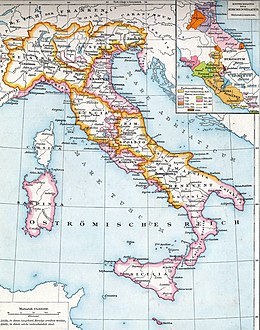
The Lombards (/ˈlɒmbərdz, -bɑːrdz, ˈlʌm-/)[1] or Longobards (Latin: Longobardi) were a Germanic people[2] who conquered most of the Italian Peninsula between 568 and 774.
The medieval Lombard historian Paul the Deacon wrote in the History of the Lombards (written between 787 and 796) that the Lombards descended from a small tribe called the Winnili,[3] who dwelt in northern Germany[4] before migrating to seek new lands. Earlier Roman-era historians wrote of the Lombards in the first century AD as being one of the Suebian peoples, also from what is now northern Germany, near the Elbe river. They migrated south, and by the end of the fifth century, the Lombards had moved into the area roughly coinciding with modern Austria and Slovakia north of the Danube. Here they subdued the Heruls and later fought frequent wars with the Gepids. The Lombard king Audoin defeated the Gepid leader Thurisind in 551 or 552, and Audoin's successor Alboin eventually destroyed the Gepids in 567. The Lombards also settled in Pannonia (modern-day Hungary). Near Szólád, archaeologists have unearthed burial sites of Lombard men and women buried together as families, unusual among Germanic peoples at the time. Contemporary traces have also been discovered of Mediterranean Greeks and a possible migrant from France.
Following Alboin's victory over the Gepids, he led his people into northeastern Italy, which had become severely depopulated and devastated after the long Gothic War (535–554) between the Byzantine Empire and the Ostrogothic Kingdom. The Lombards were joined by numerous Saxons, Heruls, Gepids, Bulgars, Thuringians and Ostrogoths, and their invasion of Italy was almost unopposed. By late 569, they had conquered all of northern Italy and the principal cities north of the Po River except Pavia, which fell in 572. At the same time, they occupied areas in central and southern Italy. They established a Lombard Kingdom in north and central Italy, which reached its zenith under the eighth-century ruler Liutprand. In 774, the kingdom was conquered by the Frankish king Charlemagne and integrated into the Frankish Empire. However, Lombard nobles continued to rule southern parts of the Italian peninsula well into the eleventh century, when they were conquered by the Normans and added to the County of Sicily. In this period, the southern part of Italy still under Lombard domination was known to the Norse as Langbarðaland ('land of the Lombards'), as inscribed in the Norse runestones.[5] Their legacy is also apparent in the name of the region of Lombardy in northern Italy.
- ^ "Lombard". Collins English Dictionary.
- ^
- Christie 1995. "The Lombards, also known as the Longobards, were a Germanic tribe whose fabled origins lay in the barbarian realm of Scandinavia."
- Whitby 2012, p. 857. "Lombards, or Langobardi, a Germanic group..."
- Brown 2005. "Lombards... a west-Germanic people..."
- Darvill 2009. "Lombards (Lombard). Germanic people..."
- Taviani-Carozzi 2005. "Lombards, A people of Germanic origin, conquerors of part of Italy from 568."
- ^ Priester 2004, p. 16: "From Proto-Germanic winna-, meaning "to fight, win"
- ^ Harrison, D.; Svensson, K. (2007). Vikingaliv. Värnamo: Fälth & Hässler. p. 74. ISBN 978-91-27-35725-9.
- ^ "2. Runriket – Täby Kyrka". Stockholm County Museum. Archived from the original on 4 June 2008. Retrieved 1 July 2007.